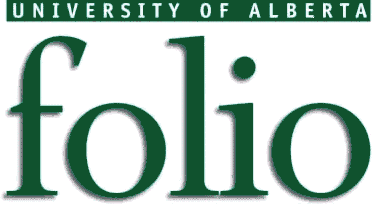
http://www.ualberta.ca/folio

| ||
| Volume 36 Number 14 | Edmonton, Canada | March 26, 1999 |
|
http://www.ualberta.ca/folio | ||

Not all of them wear lab coats: Keumhee Carriere, Tim Caulfield and James Smythe. |
Twenty-five U of A researchers received about $16 million in funding from the Alberta Heritage Foundation for Medical Research (AHFMR)-and not all of them wear lab coats.
In fact these research funds, effective July 1, are spread over a record eight faculties: medicine and dentistry; nursing; science; physical education and recreation; forestry, agriculture and human ecology; pharmacy and pharmaceutical sciences; law and for the first time, arts.
It's the highest number of U of A researchers funded in 10 years. With 40 applications submitted, the U of A had a 62.5 per cent success rate. Overall, the AHFMR funded 59 researchers, including 32 at the University of Calgary and two at the University of Lethbridge.
"It's hats off to the U of A," said Dr. Jacques Magnan, AHFMR director of grants and awards. "It's a testament to the university's screening of high-quality recruits."
Vice-President (Research and External Affairs) Roger Smith agreed: "Obviously there are synergies here. Yes, these researchers are successful because they are first-rate individuals. But they're much less likely to be here if we didn't have the AHFMR environment that was created over the last 15 years."
Health economist, James Smythe, received the Faculty of Arts' first AHFMR grant. "My research focuses on elements of the workplace and how they contribute to worker health," said Smythe, "for example, telecommuting." This has implications for employer workplace policies and could help save health-care dollars in the long run. Smythe received a $35,000 start-up grant over three years, in addition to salary support.
"This is a first that's a long time coming," said arts dean, Dr. Patricia Clements. "I think one of the challenges for research in the university is the integration of social science and medical science and other kinds of applied science research. A joint funding project like this is a step in the right direction. I think health economics are only a start."
"This is a great breakthrough for us," said Dr. Ken Norrie, chair of economics. "We hope this indicates health research and funding is not just about the medical side but also about health economics and related costs. I think the AHFMR should be congratulated for having the vision to break out of the traditional role, and I think this will be a tremendous pay-off for them." Researchers like Dr. Miriam Stewart in nursing and Dr. Keumhee Carriere in mathematical sciences are also among the 25 recipients. Stewart, a new recruit from Nova Scotia, said her $600,000 establishment grant and five-year salary support will help fund 18 projects with multidisciplinary teams in Alberta, Nova Scotia, Ontario, Manitoba and B.C.
"The whole program of research focuses on support as a determinant of health. We're looking at its influence on health status and health behaviors, and the use of health services," said Stewart. One project is investigating telephone support for family caregivers of stroke victims or seniors with Alzheimer's disease. "Over a five-month period, experienced family care-givers will be phoning new or vulnerable caregivers to provide support and information," said Stewart. Other projects look at culture, gender and socioeconomic factors on health-support services.
Carriere, a statistician, received a $155,000 establishment grant, plus salary coverage for five years. She's developing theoretical conditions for medical and health researchers to allow the accurate use of summary data analysis. "My hope is my research will allow large administrative databases around the world to become more widely available, without compromising patient confidentiality," said Carriere.
In addition, the ethical issues surrounding the genetic revolution and its commercialization have caught AHFMR interest. Tim Caulfield, of the Health Law Institute, is the first law faculty member to be funded (a visiting scholar was funded several years ago) and he's pleased to receive a $10,000, three-year renewal.
"I cannot believe how fast the area is growing.I'll probably be studying this for the rest of my life," said Caulfield. He added the grant will continue to help build international and interdisciplinary ties.
This is record-breaking funding for the AHFMR, which allotted a total of $36.9 million for 1999-00, to be expended over five years. This is a 30 per cent increase over last year's new funding. More important, the dollars cover a record number of new researchers and faculty areas in the province's three universities.

Folio front page |

Office of Public Affairs |

University of Alberta |